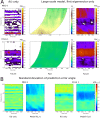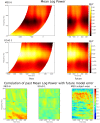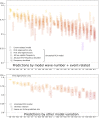Large-scale cortical travelling waves predict localized future cortical signals
- PMID: 31730613
- PMCID: PMC6894364
- DOI: 10.1371/journal.pcbi.1007316
Large-scale cortical travelling waves predict localized future cortical signals
Abstract
Predicting future brain signal is highly sought-after, yet difficult to achieve. To predict the future phase of cortical activity at localized ECoG and MEG recording sites, we exploit its predominant, large-scale, spatiotemporal dynamics. The dynamics are extracted from the brain signal through Fourier analysis and principal components analysis (PCA) only, and cast in a data model that predicts future signal at each site and frequency of interest. The dominant eigenvectors of the PCA that map the large-scale patterns of past cortical phase to future ones take the form of smoothly propagating waves over the entire measurement array. In ECoG data from 3 subjects and MEG data from 20 subjects collected during a self-initiated motor task, mean phase prediction errors were as low as 0.5 radians at local sites, surpassing state-of-the-art methods of within-time-series or event-related models. Prediction accuracy was highest in delta to beta bands, depending on the subject, was more accurate during episodes of high global power, but was not strongly dependent on the time-course of the task. Prediction results did not require past data from the to-be-predicted site. Rather, best accuracy depended on the availability in the model of long wavelength information. The utility of large-scale, low spatial frequency traveling waves in predicting future phase activity at local sites allows estimation of the error introduced by failing to account for irreducible trajectories in the activity dynamics.
Conflict of interest statement
The authors have declared that no competing interests exist.
Figures







References
Publication types
MeSH terms
Associated data
LinkOut - more resources
Full Text Sources
Miscellaneous

